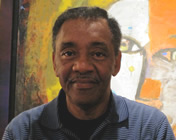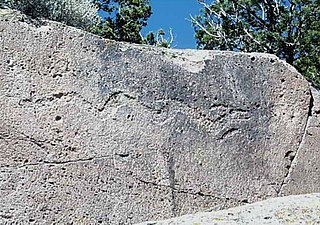 W
WLos Alamos National Laboratory is a United States Department of Energy national laboratory initially organized during World War II for the design of nuclear weapons as part of the Manhattan Project. It is located a short distance northwest of Santa Fe, New Mexico, in the southwestern United States.
 W
WThe Chemistry and Metallurgy Research Replacement Facility, usually referred to as the CMRR, is a facility under construction at Los Alamos National Laboratory in New Mexico which is part of the United States' nuclear stockpile stewardship program. The facility will replace the aging Chemistry and Metallurgy Research (CMR) facility. It is located in Technical Area 55 (TA-55) and consists of two buildings: the Nuclear Facility (CMRR-NF) and the Radiological Laboratory, Utility, and Office Building (RLUOB). The two buildings will be linked by tunnels and will connect to LANL's existing 30-year-old plutonium facility PF-4. The facility is controversial both because of spiraling costs and because critics argue it will allow for expanded production of plutonium 'pits' and therefore could be used to manufacture new nuclear weapons.
 W
WThe Lady Godiva device was an unshielded, pulsed nuclear reactor originally situated at the Los Alamos National Laboratory (LANL), near Santa Fe, New Mexico. It was one of a number of criticality devices within Technical Area 18 (TA-18). Specifically, it was used to produce bursts of neutrons and gamma rays for irradiating test samples, and inspired development of Godiva-like reactors.
 W
WThe La Mesa Fire was a 1977 wildfire on the Pajarito Plateau of New Mexico, in the Southwestern United States.
 W
WThe Los Alamos Neutron Science Center (LANSCE), formerly known as the Los Alamos Meson Physics Facility (LAMPF) is one of the world's most powerful linear accelerators. It is located in Los Alamos National Laboratory in New Mexico in Technical Area 53 (TA-53). It was the most powerful linear accelerator in the world when it was opened in June 1972. The technology used in the accelerator was developed in part by the nuclear physicist Louis Rosen. The facility is capable of accelerating protons up to 800 MeV. Multiple beamlines allow for a variety of experiments to be run at once, and the facility is used for many types of research in materials testing and neutron science. It is also used for medical radioisotope production.
 W
WLos Alamos Ranch School was a private ranch school for boys in the northwest corner of Santa Fe County, New Mexico, USA, founded in 1917 near San Ildefonso Pueblo. During World War II, the school was bought and converted into the secret nuclear research campus for Project Y. The surrounding location has developed into the town of Los Alamos.
 W
WMemento is a United States National Digital Information Infrastructure and Preservation Program (NDIIPP)–funded project aimed at making Web-archived content more readily discoverable.
 W
WMilton Dean Slaughter is an American theoretical and phenomenological physicist and affiliate professor of physics at Florida International University. Slaughter was a visiting associate professor of physics in the Center for Theoretical Physics, University of Maryland, College Park while on sabbatical from Los Alamos National Laboratory (LANL) of the University of California from 1984 to 1985. He is also chair emeritus and university research professor of physics emeritus at the University of New Orleans (UNO). Prior to joining UNO as chair of the physics department: He was a postdoctoral fellow in the LANL Theoretical Division Elementary Particles and Field Theory Group (T-8); LANL Theoretical Division Detonation Theory and Applications Group (T-14) staff physicist; LANL Theoretical Division affirmative action representative and staff physicist; LANL assistant theoretical division leader for administration and staff physicist (T-DO); LANL Nuclear and Particle Physics Group staff physicist—Medium Energy Physics Division (MP-4); and LANL Historically Black Colleges and Universities (HBCU) project manager (laboratory-wide).
 W
WThe Trident Laser is a high power, sub-petawatt class, solid-state laser facility located at Los Alamos National Laboratory, in Los Alamos, New Mexico, originally built in the late 1980s for Inertial confinement fusion (ICF) research by KMS Fusion, founded by Kip Siegel, in Ann Arbor, Michigan, it was later moved to Los Alamos in the early 1990s to be used in ICF and materials research. The system is now being decommissioned with final laser experiments being completed February 2017.
 W
W W
WThe Tritium Systems Test Assembly (TSTA) was a facility at Los Alamos National Laboratory dedicated to the development and demonstration of technologies required for fusion-relevant deuterium-tritium processing. Facility design was launched in 1977. It was commissioned in 1982, and the first tritium was processed in 1984. The maximum tritium inventory was 140 grams.
 W
WTsirege is a classic Ancestral Puebloan archaeological site located north of Pajarito Road about one mile west of White Rock, New Mexico on property owned by Los Alamos National Laboratory. Tsirege consists of approximately 800 rooms, was occupied from c. 1325 to c. 1600, and is regarded by the people of San Ildefonso Pueblo as ancestral. The name means "bird place" in the Tewa language. The site includes a long defensive wall, 10 kivas, a reservoir, and many significant petroglyph panels. Tours of the site are rarely offered.